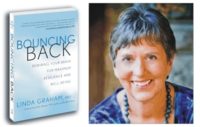When we are resilient, we are able to respond quickly, creatively and effectively to external events, whether everyday challenges or life-changing crises.
~ Linda Graham ~
Toward a Transformation of Consciousness
Joseph Campbell intended the Hero’s Journey to be more than a heuristic for studying myth: he meant for it to be a guide for understanding and navigating our everyday lives. The journey, he felt, describes the amplification or transformation of consciousness required for us to grow and adapt to changes in our world and ourselves. “Every failure to cope with a life situation,” he wrote, “must be laid, in the end, to a restriction of consciousness” (1949).
According to Campbell (1988), consciousness is transformed by the trials and revelations we experience during a journey. These trials force us to examine our “understandings”: those beliefs, attitudes and behaviors that guide us through our lives. During the journey we must abandon or revise ineffective or maladaptive understandings and build new understandings that allow us to live more effectively and fully.
To do this, we need to have the courage to embrace challenges and to “bounce back” from adversity: we need resilience. In fact, resilience and developing resilience are keys to the journey. Let’s take a minute to look at resilience and how it relates to the transformation of consciousness Campbell describes.
What is Resilience?
According to Linda Graham, author of Bouncing Back: Rewiring Your Brain for Resilience and Well Being, “Resilience is an innate capacity in the brain that allows us to face and deal with the challenges and crises that are inevitable to the human condition.” When we are resilient, we are able to respond quickly, creatively and effectively to external events, whether everyday challenges or life-changing crises.
While the potential for resilience is innate in our brain, over time we may learn maladaptive coping techniques. Usually, we develop these techniques as children, learning them from our experiences and the people around us—especially if those people, themselves, lack resilience. Because these techniques worked then, we tended to use them over and over, until they become fixed in our neural circuitry as our default mode of facing challenges. As a result, we may never learn other, more mature and flexible coping tools. Unfortunately, when we are adults, these childhood patterns may continue to dictate how we respond to life’s challenges, leaving us trying to handle adult challenges with childhood coping techniques.
Fortunately, however, this childhood neural “wiring” can be changed. Our brains have a capacity called “neuroplasticity,” the ability to grow new neurons and create new neural pathways. By choosing experiences and responses that will “wire” our brain rather than relying simply on conditioned reactions, we can develop more effective and flexible patterns of coping. Doing this is not easy, but many experts, including Graham, have developed techniques to facilitate the process. (For a discussion of resilience and what we can do to develop it, check out this 15-minute audio interview Dr. Graham did with New Dimensions Radio.)
Developing Resilience
Building resilience means developing our ability to step back from a problem, evaluate it objectively and to respond creatively and effectively. Understanding the journey can help us with this process. When we understand the full pattern of the journey, we gain perspective on an experience and how it relates to our lives in general. From this greater perspective, by seeing the “greater story” of our lives, we are better able to see more options and potentials. We develop skills to cope more effectively with challenges and to grow from them.
As we respond to challenges in the journey, often with the help of a mentor or helpers, we build resilience, but we also expand our understanding of the world and our place in it. Being able to adapt our coping techniques to a specific challenge is the skill that allows us to find our footing when we’re thrown off balance by the unknown, by stress, or by trauma. Developing this capacity to be resilient in the face of challenge is one of the Hero’s Journey’s greatest gifts.
References
Campbell, J. (1949). The Hero with a Thousand Faces (2nd ed.). Princeton, NJ: Princeton University.
Campbell, J. (1988). The Power of Myth. (wth B. Moyers). New York: Doubleday.
Graham, L. Mindfulness, self-compassion and resilience. Linda Graham: Resources for recovering resilience. Accessed 12/8/2017. https://lindagraham-mft.net/mindfulness-self-compassion-and-resilience/.
